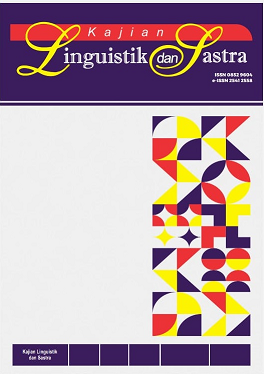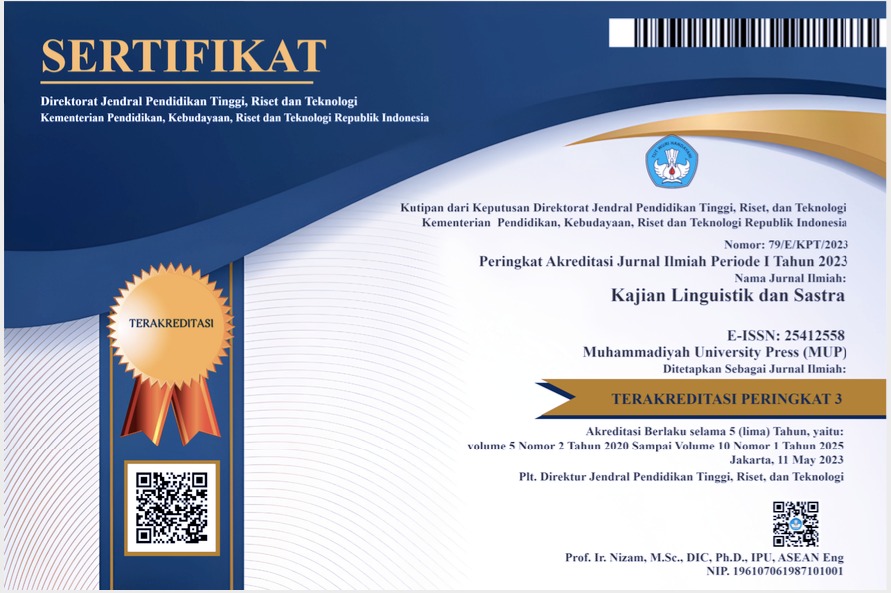Dekonstruksi Pemadanan Verba Berdiatesis Aktif Bahasa Jerman dalam Novel Bahasa Indonesia
Keywords:
translation, deconstruction, equivalence, active voicesAbstract
This translation research is a process of proving deconstructions as implications and negotiations of
linguistics and culture committed by a translator. Through a descriptive-qualitative approach with
advanced comparative and interpretive methods, this study investigated deconstructions of equivalence
in voice verbs of the German language in Indonesian novels across eras, namely the first translated novel
in 1978 and the second one in 1991. Different translators in other eras translated both novels. The data
of this study are declarative sentences that have active voices in the German language and were
collected through the note-taking technique and sampling. Based on Derrida’s theory, that language is
not constant, and Mona Baker’s translation theory, the collected data were analyzed. The result of this
study indicated that translation deconstructions in TSu (source text) occurred in TSa1 (target text or the
1
st translations) and TSa2(target text or the 2nd translations of another era). The deconstructions covered
3 (three) levels: these are at word-form levels, meaning levels, and information structure levels. Those
levels were elaborated in gaining the meaning equivalence. At the word-form level were obtained verbs
of active voices of the German language were obtained in the form (i) basic verbs, (ii) verbs with prefixes,
dan (iii) verb blends. These forms are then translated into (1) verbs with a variety of forms, (2) affixed
nouns, (3) word groups, and (4) modality, aspectuality, and grammatical function. At the meaning level
were found active meanings and passive meanings containing propositional meanings, expressive
meanings, evoked meanings, and metaphorical meanings. At the last levels, outlined variations of the
information structures in target languages through tematisation.
Downloads
References
[1] C. Norris, Membongkar Teori Dekonstruksi (I.R. Muzir, Terjemahan), 2nd ed. Yogyakarta:
Ar Ruzz Media Group, 2017.
[2] J. Derrida, Of Grammatoogy. (G. Chakravoerty, Terjemahan), 3rd ed. Baltimore, Maryland:
The Johns Hopkins University Press, 1997.
[3] B. H. Hoed, Penerjemahan dan Kebudayaan. Jakarta: PT Dunia Pustaka Jaya, 2006.
[4] J. Levy, The Art of Translation. Amsterdam: John Benjamins Publishing, 2011.
[5] L. Venuti, The Translation Studies Reader, 1st ed. London dan Newyork: Routledge, 2000.
[6] M. Baker, In Other Words: A Coursebook onTranslation. London: Routledge, 2018.
[7] K. Artawa, “Pemarkahan Diatesis Bahasa Indonesia:,” Mozaik Hum., vol. 20, no. 1, p. 26,
2020, doi: 10.20473/mozaik.v20i1.15128.
[8] Nur Suryanah and Masta Hutajulu, “Kalimat Berdiatesis Aktif - Pasif pada Kumpulan Cerpen
Dilarang Menyanyi di Kamar Mandi Karya Seno Gumira Ajidarma,” Risenologi, vol. 6, no. 2,
pp. 32–35, 2021, doi: 10.47028/j.risenologi.2021.62.186.
[9] D. Yogyanti, “Implikasi Diathesis Pada Struktur Sintaksis Bahasa Jepang,” JISIP (Jurnal Ilmu
Sos. dan Pendidikan), vol. 6, no. 3, pp. 10412–10423, 2022, doi: 10.58258/jisip.v6i3.3434.
[10] Q. Fitrie, S. Tisnasari, and A. Supena, “Analisis Kontrastif Afiksasi Verba Bahasa Jawa Dialek
Banten Dan Bahasa Indonesia Dalam Kanal Youtube Guyonan Pegandikan Periode 2021,”
Bahtera Indones. J. Penelit. Pendidik. Bhs. dan Sastra Indones., vol. 8, no. 2, pp. 401–413,
2023, doi: https://doi.org/10.31943/bi.v8i2.428.
[11] P. M. Kadir, I. I. Sidiq, and C. Sobarna, “Analisis Kontrastif Pasangan Kalimat Transitif-
Intransitif Bahasa Indonesia dan Bahasa Jepang,” Ranah J. Kaji. BahasaJurnal Kaji. Bhs.,
vol. 12, no. 2, pp. 488–499, 2023, doi: https://doi.org/10.26499/rnh.v12i2.6207 Abstrak.
[12] R. D. S. Dilis, S. M. E. Bingku, and S. J. Lendo, “Analisis Kontrastif Wortstellung Dalam
Kalimat Sederhana Bahasa Jerman Dan Bahasa Inggris,” Kompetensi J. Bhs. dan Seni, vol.
3, no. 9, pp. 2547–2560, 2023, doi: 10.53682/kompetensi.v3i9.6523.
[13] N. D. Arrasyid, “Analisis Kontrastif Penanda Negasi dalam Kalimat Bahasa Prancis dan
Bahasa Indonesia,” Mimesis, vol. 3, no. 2, pp. 137–149, 2022, doi:
https://doi.org/10.12928/mms.v3i2.6241.
[14] G. F. F. Tumbole and S. Roman, “Pengaruh Prosedur Penerjemahan Pola dan Jenis Kalimat
Bahasa Indonesia dan Inggris dalam Novel Terjemahan Calon Arang: Sebuah Analisis
Kontrastif,” Prasasti J. Linguist., vol. 7, no. 1, p. 18, 2022, doi:
10.20961/prasasti.v7i1.57477.
[15] Farid Ma’ruf, T. Akhmad, and A. Edwar, “Penerjemahan Klausa Transitif dari Bahasa Arab
ke Dalam Bahasa Indonesia,” Alim J. Islam. Educ., vol. 3, no. 2, pp. 127–138, 2021.
[16] H. Latif, “Dinamika Terjemahan Al-Qur’an Bebas Bersajak dalam Bahasa Aceh: Apresiasi
Karya Tgk. H. Mahjiddin Jusuf,” J. Ilm. Al-Mu’ashirah, vol. 18, no. 1, p. 30, 2021, doi:
10.22373/jim.v18i1.10453.
[17] S. Sajarwa, “Deconstructing Equivalence in the Translation of Texts from French to
Indonesian,” J. Hum., vol. 29, no. 2, p. 159, 2017, doi: 10.22146/jh.v29i2.24063.
[18] Masduki, “Analysing Novel Translation: The Equivalence of Meaning and Style,” Kaji.
Linguist. dan Sastra, vol. 23, no. 2, pp. 177–186, 2011, [Online]. Available:
https://journals.ums.ac.id/index.php/KLS/article/view/4312
[19] A. Aulia and R. Kartolo, “Analisis Unsur Intrinsik dalam Novel Janshen Karya Risa
Saraswati,” J. Abil. J. Educ. Soc. Anal., vol. 4, no. 1, pp. 65–77, 2023, doi:
https://doi.org/10.51178/jesa.v4i1.1073.
[20] E. E. Kästner, Emil und die Detektive. Zȕrich: Atrium Verlag, 1935.
[21] E. E. Kästner, Emil dan Polisi-polisi Rahasia (Ny. M. Saleh Saad, Terjemahan). Jakarta:
Djambatan, 1978.
[22] E. E. Kästner, Emil dan Detektif-detektif Cilik (Agus Setiadi, Terjemahan). Jakarta:
Gramedia, 1991.
[23] L. J. Moleong, Metode Penelitian Kualitatif. Bandung: Remaja Rosdakarya, 2016.
[24] Sudaryanto, Metode dan Aneka Teknik Analisis Bahasa. Yogyakarta: Sanata Dharma
University Pres, 2015.
[25] A. Sutrisno, Metodologi Penelitian Bahasa. Yogyakarta: Fakultas Ilmu Budaya Universitas
Gadjah Mada;, 2021.
[26] T. M. J. Kesuma, Pengantar (Metode) Penelitian Bahasa. Yogyakarta: Carasvatibooks,
2007.
[27] A. Heuken, Kamus Jerman Indonesia, 10th ed. Jakarta: PT Gramedia Pustaka Utama, 2009.
[28] Berlin-Brandenburgische Akademie der Wissenschaften (BBAW), “DWDS-Digitales
Wȍrterbuch der deutschen Sprache.” Accessed: Sep. 16, 2024. [Online]. Available:
[29] A. Chaer, Linguistik Umum, 4th ed. Jakarta: Rineka Cipta, 2014.
[30] S. Bassnett, Translation studies, 3rd ed. London and New York: Routledge, 2002. doi:
10.4324/9780203488232.
[31] B. P. dan P. Bahasa, “KBBI VI [Daring].” Accessed: Jun. 01, 2024. [Online]. Available:
https://kbbi.kemdikbud.go.id/entri/Profesor
[32] E. Hentschel, De Gruyter Lexikon: Deutsche Grammatik. Berlin: Walter de Gruyter GmbH
& Co. KG, 2010.
[33] A. M. Moeliono, H. Lapoliwa, H. Alwi, S. S. Tjatur, W. Sasangka, and Sugiyono, Tata Bahasa
Baku Bahasa Indonesia, 4th ed. Jakarta: Badan Pengembangan dan Pembinaan Bahasa
Kementrian Pendidikan dan Kebudayaan, 2017.
[34] P. Barry, Beginning Theory: An Introduction to Literary and Cultural Theory, 2nd ed. New
York: Manchester University Press, 2022.
[35] G. Helbig and J. Buscha, Deutsche Grammatik. Leipzig: Verlag Enzyklopȁdie, 2005.
[36] P. Eisenberg, Die Grammatik, 9th ed. Berlin: Dudenverlag, 2016. [Online]. Available:
www.duden.de
[37] S. Athifatuzzahra, Y. Mutiarsih, and I. Sopiawati, “Analisis Prosedur Penerjemahan
Transposisi dalam Novel ‘Kemolekan Landak,’” Silampari Bisa J. Penelit. Pendidik. Bhs.
Indones. Daerah, dan Asing, vol. 7, no. 2, pp. 57–70, 2024, doi:
10.31540/silamparibisa.v1i1.4.
[38] S. D. Rahmawati, R. A. Wibowo, and N. Nurjanah, “Analisis Penggunaan Hiponimi pada
Unggahan Akun Instagram Pribadi Wakil Presiden Ma’ruf Amin,” Alinea J. Bhs. Sastra dan
Pengajaran, vol. 4, no. 1, pp. 135–146, 2024, [Online]. Available:
http://ejournal.baleliterasi.org/index.php/alinea
[39] S. Yazan, Arwemi, and G. H. Elmizan, “Deiksis Waktu dan Waktu Referensial dalam Sastra
Lisan Minangkabau,” Jentera J. Kaji. Sastra, vol. 11, no. 1, pp. 331–340, 2022, doi: doi:
https://doi.org/10.26499/jentera.v11i2.5204.
[40] H. L. S. Suwignyo, A. Santoso, and Martutik, “Pengalaman dalam Bahasa Indonesia:
Kategorisasi dan Metafora Konseptual,” Linguist. Indones., vol. 43, no. 1, pp. 171–185,
2025, doi: https://doi.org/10.26499/li.v43i1.754.
[41] R. Prayogi, B. Riadi, and R. A. Prasetya, “Analisis Penggunaan Kata Keterangan dalam
Artikel pada Kolom Opini Surat Kabar Harian Kompas,” J-Simbol J. Magister Pendidik. Bhs.
dan Sastra Indones., vol. 9, no. 1, pp. 1–5, 2021, doi: DOI:10.23960/J-Simbol/v9i1.2021.1.










